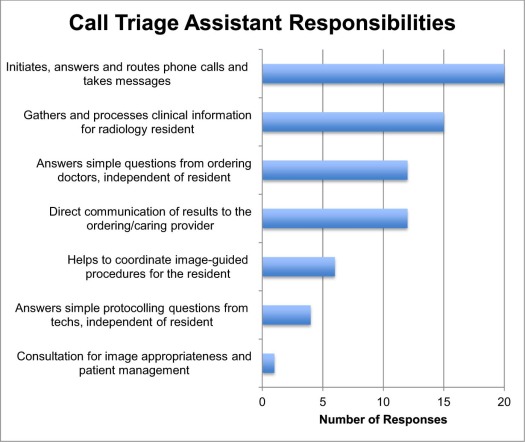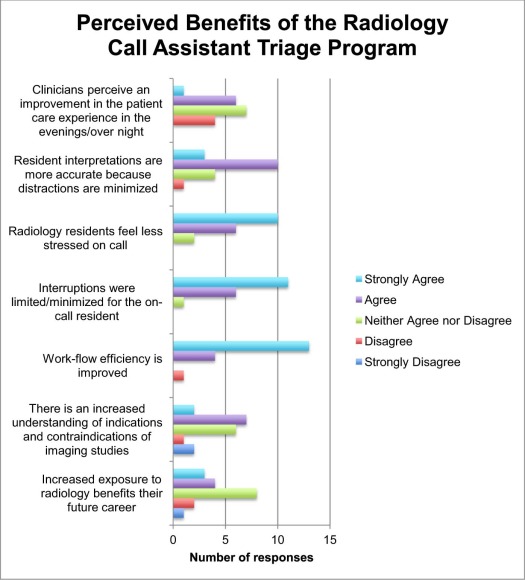Rationale and Objectives
Given increasing volume and workflow interruptions in radiology, we sought to identify and characterize radiology call assistant triage (RCAT) programs among US radiology residency programs.
Materials and Methods
A survey was created using Qualtrics survey software and emailed to all members of the Association of Program Directors in Radiology listserv. A total of 296 active members belong to this listserv, including program directors and assistant program directors. The survey included questions about the existence and specifics of a call triage assistant program.
Results
Data were obtained from 88 active members of the Association of Program Directors in Radiology (30% response rate). Of those, 20 programs (23%) have an RCAT program. Triage assistant staffing includes nonmedical or clerical staff (60%), medical students (30%), first-year radiology residents (5%), and technologists (5%). All respondents with RCAT programs report satisfaction with their program and plan to continue. A significant majority (75%) have no plans to change, whereas the remaining 25% are considering program expansion and pay increases. Among residency programs without RCAT programs, none reported termination of their triage program. The most common reasons for not having triage assistants include cost, lack of awareness, differing opinions on utility, and the presence of 24/7 attending coverage.
Conclusion
Twenty US radiology residency programs report having an RCAT program. All report satisfaction with their program despite different staffing models. RCAT programs may represent an effective measure in limiting interruptions and potentially decreasing interpretative errors made by residents on call.
Introduction
The volume and complexity of radiology studies continue to climb nationally on an annual basis. Between 1998 and 2001, there was a 5% annual increase in radiology studies performed in the United States , largely driven by magnetic resonance imaging, computed tomography (CT), ultrasound, nuclear medicine, mammography, and interventional procedures. In contrast, the number of radiologists was estimated to be increasing at a rate of only 1.5% annually . To compound this issue, the complexity of examinations is also increasing: relative value units per full time equivalent increased by 22% from 2003 to 2006 .
Community and academic practices alike are feeling the effects of the increasing volume and complexity of radiology examinations. Radiology residents might be particularly sensitive to increases in volume, especially during independent call. This has driven radiology residency programs to evaluate radiology workflow structure to help address rising volumes, increase workflow efficiency, and minimize the impact of frequent interruptions.
Get Radiology Tree app to read full this article<
Get Radiology Tree app to read full this article<
Get Radiology Tree app to read full this article<
Get Radiology Tree app to read full this article<
Materials and Methods
Get Radiology Tree app to read full this article<
Get Radiology Tree app to read full this article<
Get Radiology Tree app to read full this article<
Results
Get Radiology Tree app to read full this article<
Get Radiology Tree app to read full this article<
Get Radiology Tree app to read full this article<
Get Radiology Tree app to read full this article<
Get Radiology Tree app to read full this article<
Get Radiology Tree app to read full this article<
Get Radiology Tree app to read full this article<
Get Radiology Tree app to read full this article<
Get Radiology Tree app to read full this article<
Get Radiology Tree app to read full this article<
Get Radiology Tree app to read full this article<
Get Radiology Tree app to read full this article<
Discussion
Get Radiology Tree app to read full this article<
Get Radiology Tree app to read full this article<
Get Radiology Tree app to read full this article<
Get Radiology Tree app to read full this article<
Get Radiology Tree app to read full this article<
Conclusion
Get Radiology Tree app to read full this article<
Supplementary Data
Get Radiology Tree app to read full this article<
Appendix S1
Get Radiology Tree app to read full this article<
Get Radiology Tree app to read full this article<
Get Radiology Tree app to read full this article<
References
1. Bhargavan M., Sunshine J.H.: Utilization of radiology services in the United States: levels and trends in modalities, regions, and populations. Radiology 2005; 234: pp. 824-832.
2. Lu Y., Zhao S., Chu P.W., et. al.: An update survey of academic radiologists’ clinical productivity. J Am Coll Radiol 2008; 5: pp. 817-826.
3. Kohn L.T., Corrigan J.M., Donaldson M.S.: Institute of Medicine.2000.The National Academies PressWashington DC https://doi.org/10.17226/9728
4. Dhanoa D., Dhesi T.S., Burton K.R., et. al.: The evolving role of the radiologist: the Vancouver workload utilization evaluation study. J Am Coll Radiol 2013; 10: pp. 764-769.
5. Yu J.-P.J., Kansagra A.P., Mongan J.: The radiologist’s workflow environment: evaluation of disruptors and potential implications. J Am Coll Radiol 2014; 11: pp. 589-593.
6. Balint B.J., Steenburg S.D., Lin H., et. al.: Do telephone call interruptions have an impact on radiology resident diagnostic accuracy?. Acad Radiol 2014; 21: pp. 1623-1628.
7. Davis D.J., Moon M., Kennedy S., et. al.: Introducing medical students to radiology as paid emergency department triage assistants. J Am Coll Radiol 2011; 8: pp. 710-715.
8. Chen J.Y., Lewis P.J.: The value of a medical student radiology triage program in enhancing clinical education and skills. Acad Radiol 2014; 21: pp. 829-833.
9. Dobre M.C., Maley J.: Medical student radiology externs: increasing exposure to radiology, improving education, and influencing career choices. J Am Coll Radiol 2012; 9: pp. 506-509. e5

